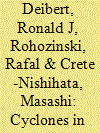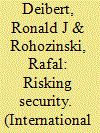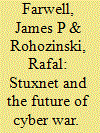|
|
|
Sort Order |
|
|
|
Items / Page
|
|
|
|
|
|
|
| Srl | Item |
| 1 |
ID:
110833


|
|
|
|
|
| Publication |
2012.
|
| Summary/Abstract |
While the rhetoric of cyber war is often exaggerated, there have been recent cases of international conflict in which cyberspace has played a prominent role. In this article, we analyze the impact of cyberspace in the conflict between Russia and Georgia over the disputed territory of South Ossetia in August 2008. We examine the role of strategic communications, information operations, operations in and through cyberspace, and conventional combat to account for the political and military outcomes of the conflict. The August 2008 conflict reveals some emergent issues in cyber warfare that can be generalized for further comparative research: the importance of control over the physical infrastructure of cyberspace, the strategic and tactical importance of information denial, the emergence of cyber-privateering, the unavoidable internationalization of cyber conflicts, and the tendency towards magnifying unanticipated outcomes in cyber conflicts - a phenomenon we call 'cyclones in cyberspace'.
|
|
|
|
|
|
|
|
|
|
|
|
|
|
|
|
| 2 |
ID:
095500


|
|
|
|
|
| Publication |
2010.
|
| Summary/Abstract |
Conceptualizations of cyberspace security can be divided into two related dimensions, articulated as "risks": risks to the physical realm of computer and communication technologies (risks to cyberspace); and risks that arise from cyberspace and are facilitated or generated by its technologies, but do not directly target the infrastructures per se (risks through cyberspace). There is robust international consensus, growing communities of practice, and an emerging normative regime around risks to cyberspace. This is less the case when it comes to risks through cyberspace. While states do collaborate around some policy areas, cooperation declines as the object of risk becomes politically contestable and where national interests vary widely. These include the nature of political opposition and the right to dissent or protest, minority rights and independence movements, religious belief, cultural values, or historical claims. The contrast between the domains has led to contradictory tendencies and paradoxical outcomes.
|
|
|
|
|
|
|
|
|
|
|
|
|
|
|
|
| 3 |
ID:
102408


|
|
|
|
|
| Publication |
2011.
|
| Summary/Abstract |
The discovery in June 2010 that a cyber worm dubbed 'Stuxnet' had struck the Iranian nuclear facility at Natanz suggested that, for cyber war, the future is now. Stuxnet has apparently infected over 60,000 computers, more than half of them in Iran; other countries affected include India, Indonesia, China, Azerbaijan, South Korea, Malaysia, the United States, the United Kingdom, Australia, Finland and Germany. The virus continues to spread and infect computer systems via the Internet, although its power to do damage is now limited by the availability of effective antidotes, and a built-in expiration date of 24 June 2012.
|
|
|
|
|
|
|
|
|
|
|
|
|
|
|
|
|
|
|
|
|